2014 Peugeot 508 oil pressure
[x] Cancel search: oil pressurePage 23 of 352
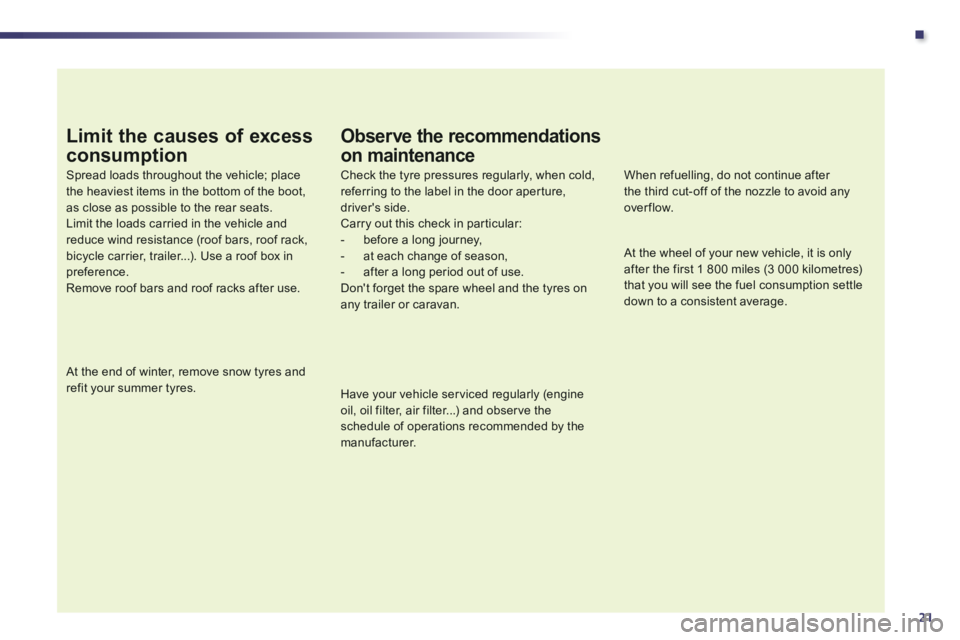
.
21
Limit the causes of excess
consumption
Spread loads throughout the vehicle; place the heaviest items in the bottom of the boot, as close as possible to the rear seats. Limit the loads carried in the vehicle and reduce wind resistance (roof bars, roof rack, bicycle carrier, trailer...). Use a roof box in preference. Remove roof bars and roof racks after use.
At the end of winter, remove snow tyres and refit your summer tyres.
Observe the recommendations
on maintenance
Check the tyre pressures regularly, when cold, referring to the label in the door aperture, driver's side.
Carry out this check in particular: - before a long journey, - at each change of season, - after a long period out of use. Don't forget the spare wheel and the tyres on any trailer or caravan.
Have your vehicle serviced regularly (engine oil, oil filter, air filter...) and observe the schedule of operations recommended by the manufacturer.
When refuelling, do not continue after the third cut-off of the nozzle to avoid any over flow.
At the wheel of your new vehicle, it is only after the first 1 800 miles (3 000 kilometres) that you will see the fuel consumption settle down to a consistent average.
Page 30 of 352
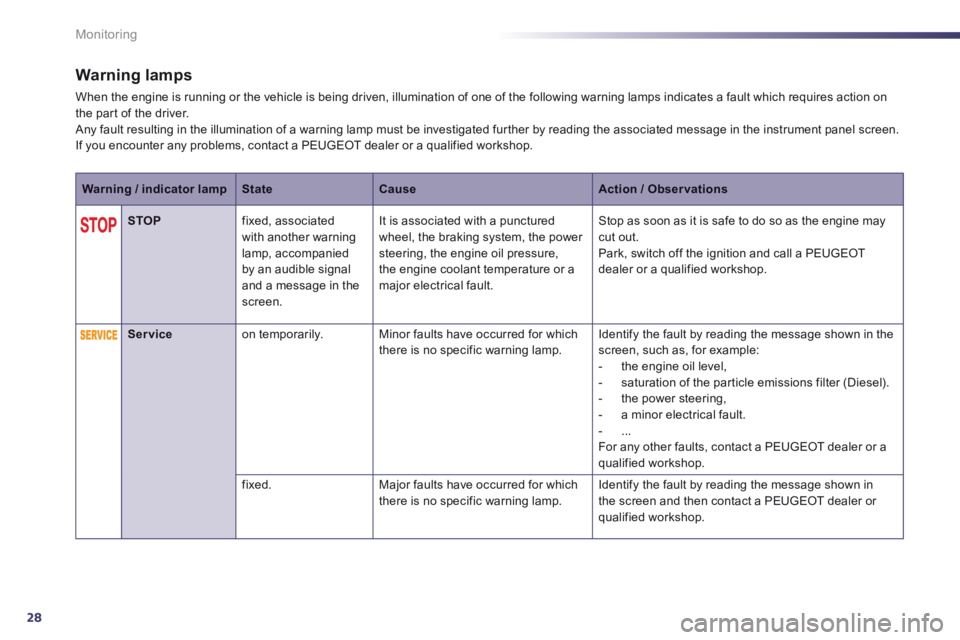
28
Monitoring
Warning lamps
When the engine is running or the vehicle is being driven, illumination of one of the following warning lamps indicates a fault which requires action on the part of the driver. Any fault resulting in the illumination of a warning lamp must be investigated further by reading the associated message in the instrument panel screen. If you encounter any problems, contact a PEUGEOT dealer or a qualified workshop.
Warning / indicator lampStateCauseAction / Observations
STOP fixed, associated with another warning lamp, accompanied by an audible signal and a message in the screen.
It is associated with a punctured wheel, the braking system, the power steering, the engine oil pressure, the engine coolant temperature or a major electrical fault.
Stop as soon as it is safe to do so as the engine may cut out. Park, switch off the ignition and call a PEUGEOT dealer or a qualified workshop.
Service on temporarily. Minor faults have occurred for which there is no specific warning lamp. Identify the fault by reading the message shown in the screen, such as, for example: - the engine oil level, - saturation of the particle emissions filter (Diesel). - the power steering, - a minor electrical fault. - ... For any other faults, contact a PEUGEOT dealer or a qualified workshop.
fixed. Major faults have occurred for which there is no specific warning lamp. Identify the fault by reading the message shown in the screen and then contact a PEUGEOT dealer or qualified workshop.
Page 33 of 352

1
31
Monitoring
Warning or indicator lamp in the instrument panel StateCauseAction / Observations
Engine oil pressure fixed. There is a fault with the engine lubrication system. You must stop as soon it is safe to do so. Park, switch off the ignition and contact a PEUGEOT dealer or a qualified workshop.
Battery charge fixed. The battery charging circuit has a fault (dirty or loose terminals, slack or cut alternator belt, ...).
The warning lamp should go off when the engine is started. If it does not go off, contact a PEUGEOT dealer or a qualified workshop.
Door(s) open fixed, associated with a message identifying the door, if the speed is below 6 mph (10 km/h).
A door or the boot is still open. Close the door or boot.
fixed, associated with a message identifying the door, and accompanied by an audible signal if the speed is above 6 mph (10 km/h).
Page 35 of 352

1
33
Monitoring
Coolant temperature gauge
With the engine running, when the needle is: - in zone A , the temperature is correct, - in zone B , the temperature is too high; the central STOP warning lamp comes on, accompanied by an audible signal and a message in the instrument panel screen. You MUST stop as soon as it is safe to do so. Wait a few minutes before switching off the engine. Contact a PEUGEOT dealer or a qualified workshop.
After driving for a few minutes, the temperature and pressure in the cooling system increase. To top up the level: wait for the engine to cool, unscrew the cap by two turns to allow the pressure to drop, when the pressure has dropped, remove the cap, top up the level to the "MA X" mark.
On switching on the ignition or when driving, it indicates the engine oil temperature. With the needle in zone C , the temperature is correct. With the needle in zone D , the temperature is too high. Slow down to lower the oil temperature.
Engine oil temperature
gauge
Be aware of the risk of burns when topping up the cooling system. Do not fill above the maximum level (indicated on the reservoir).
Page 185 of 352
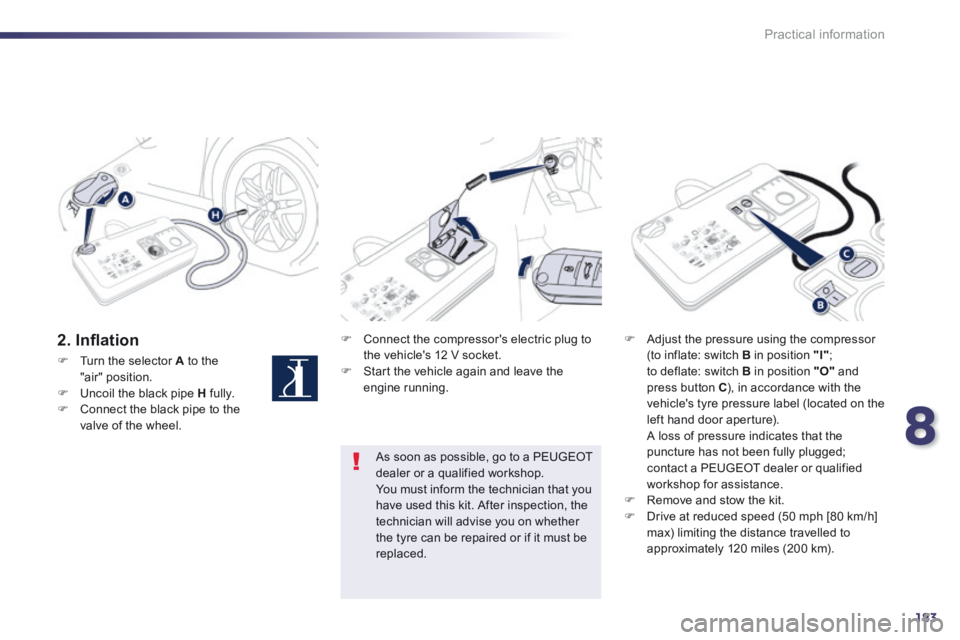
8
183
Practical information
2 . I n fl a t i o n Connect the compressor's electric plug to the vehicle's 12 V socket. Start the vehicle again and leave the engine running.
Adjust the pressure using the compressor (to inflate: switch B in position "I" ; to deflate: switch B in position "O" and press button C ), in accordance with the vehicle's tyre pressure label (located on the left hand door aperture). A loss of pressure indicates that the puncture has not been fully plugged; contact a PEUGEOT dealer or qualified workshop for assistance. Remove and stow the kit. Drive at reduced speed (50 mph [80 km/h] max) limiting the distance travelled to approximately 120 miles (200 km).
As soon as possible, go to a PEUGEOT dealer or a qualified workshop. You must inform the technician that you have used this kit. After inspection, the technician will advise you on whether the tyre can be repaired or if it must be replaced.
Turn the selector A to the "air" position. Uncoil the black pipe H fully. Connect the black pipe to the valve of the wheel.
Page 186 of 352

184
Practical information
Removing the cartridge
Stow the black pipe. Detach the angled base from the white pipe. Support the compressor vertically. Unscrew the cartridge from the bottom.
Beware of discharges of fluid. The expiry date of the fluid is indicated on the cartridge. The sealant cartridge is designed for single use; even if only partly used, it must be replaced. After use, do not discard the cartridge into the environment, take it to an authorised waste disposal site or a PEUGEOT dealer.
Do not forget to obtain a new sealant cartridge, available from PEUGEOT dealers or from a qualified workshop.
Checking tyre pressures /
inflating accessories
You can also use the compressor, without injecting any product, to: - check or adjust the pressure of your tyres, - inflate other accessories (balls, bicycle tyres...).
Turn the selector A to the "Air" position. Uncoil the black pipe H fully. Connect the black pipe to the valve of the wheel or accessory. If necessary, fit one of the adaptors supplied with the kit first.
Connect the compressor's electrical connector to the vehicle's 12 V socket. Start the vehicle and let the engine run. Adjust the pressure using the compressor (to inflate: switch B in position "I" ; to deflate: switch B in position "O" and press button C ), according to the vehicle's tyre pressure label or the accessory's pressure label. Remove the kit then stow it.
Page 229 of 352
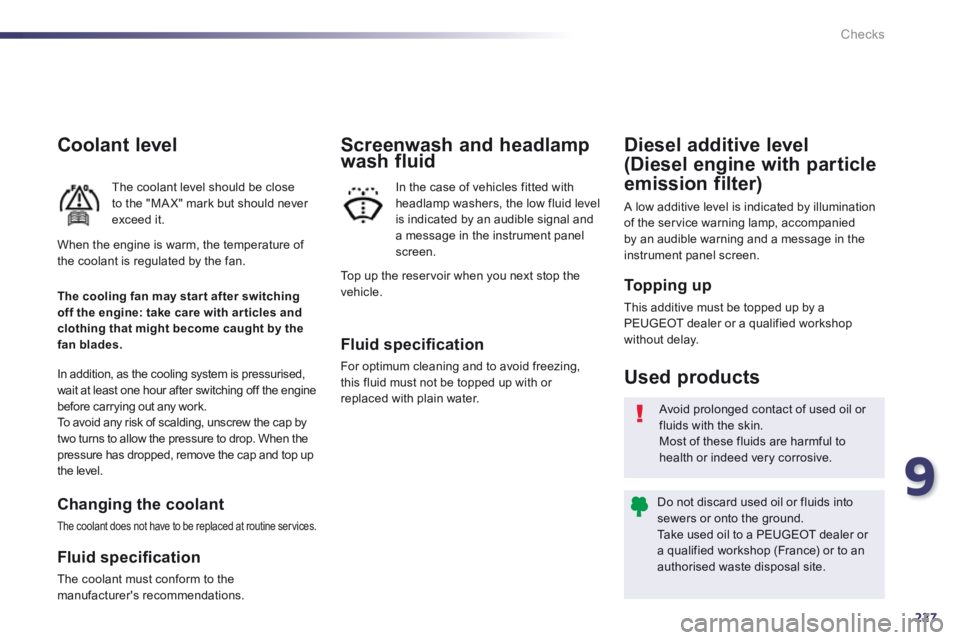
9
227
Checks
Coolant level
The coolant level should be close to the "MA X" mark but should never exceed it.
In addition, as the cooling system is pressurised, wait at least one hour after switching off the engine before carrying out any work. To avoid any risk of scalding, unscrew the cap by two turns to allow the pressure to drop. When the pressure has dropped, remove the cap and top up the level.
Changing the coolant
The coolant does not have to be replaced at routine services.
Fluid specifi cation
The coolant must conform to the manufacturer's recommendations.
Fluid specifi cation
For optimum cleaning and to avoid freezing, this fluid must not be topped up with or replaced with plain water.
Screenwash and headlamp wash fluid Screenwash and headlamp wash fluid Screenwash and headlamp
In the case of vehicles fitted with headlamp washers, the low fluid level is indicated by an audible signal and a message in the instrument panel screen.
The cooling fan may star t after switching off the engine: take care with ar ticles and clothing that might become caught by the fan blades.
Avoid prolonged contact of used oil or fluids with the skin.
Most of these fluids are harmful to health or indeed very corrosive.
Do not discard used oil or fluids into sewers or onto the ground. Take used oil to a PEUGEOT dealer or a qualified workshop (France) or to an authorised waste disposal site.
Used products
Topping up
This additive must be topped up by a PEUGEOT dealer or a qualified workshop without delay.
Diesel additive level
(Diesel engine with particle
emission filter)
A low additive level is indicated by illumination of the service warning lamp, accompanied by an audible warning and a message in the instrument panel screen. When the engine is warm, the temperature of the coolant is regulated by the fan. Top up the reservoir when you next stop the vehicle.
Page 231 of 352
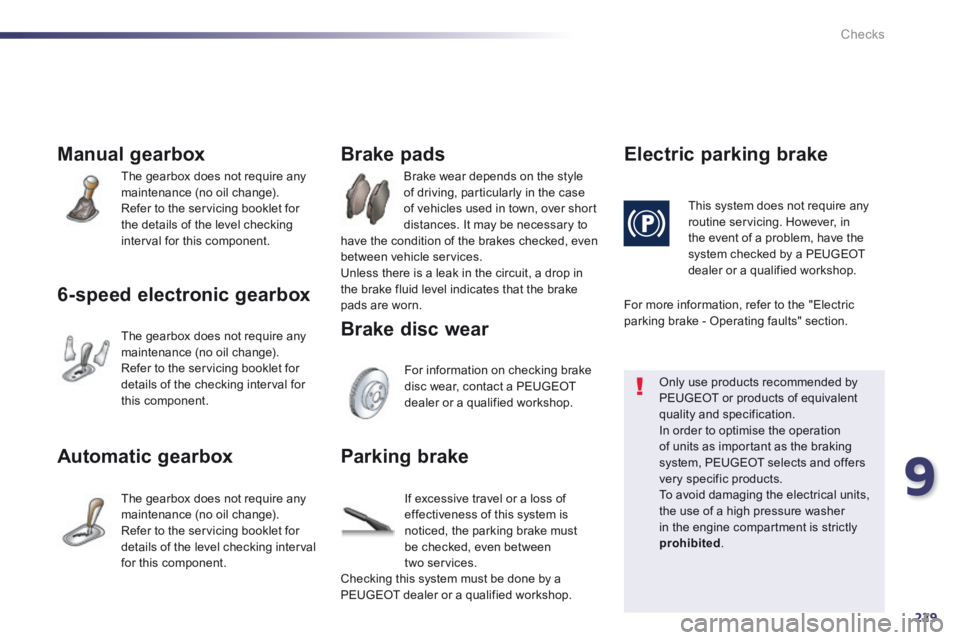
9
229
Checks
Manual gearbox
The gearbox does not require any maintenance (no oil change). Refer to the servicing booklet for the details of the level checking interval for this component.
6-speed electronic gearbox
The gearbox does not require any maintenance (no oil change). Refer to the servicing booklet for details of the checking interval for this component.
Automatic gearbox
The gearbox does not require any maintenance (no oil change). Refer to the servicing booklet for
details of the level checking interval for this component.
Brake wear depends on the style of driving, particularly in the case of vehicles used in town, over short distances. It may be necessary to have the condition of the brakes checked, even between vehicle services. Unless there is a leak in the circuit, a drop in the brake fluid level indicates that the brake pads are worn.
Brake pads
For information on checking brake disc wear, contact a PEUGEOT dealer or a qualified workshop.
Brake disc wear
Electric parking brake
This system does not require any routine servicing. However, in the event of a problem, have the system checked by a PEUGEOT dealer or a qualified workshop.
Only use products recommended by PEUGEOT or products of equivalent quality and specification.
In order to optimise the operation of units as important as the braking system, PEUGEOT selects and offers very specific products. To avoid damaging the electrical units, the use of a high pressure washer in the engine compartment is strictly prohibited .
Parking brake
If excessive travel or a loss of effectiveness of this system is noticed, the parking brake must
be checked, even between two services. Checking this system must be done by a PEUGEOT dealer or a qualified workshop.
For more information, refer to the "Electric parking brake - Operating faults" section.